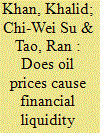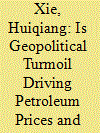| Srl | Item |
| 1 |
ID:
162308


|
|
|
|
|
| Summary/Abstract |
In China, a large private sector has evolved alongside a still sizeable state-owned sector that is subject to government control. Several studies have found that in this mixed economy, the private sector is economically more efficient than the state-owned sector. In this paper, we investigate whether private firms are also more carbon efficient than state-owned firms. Using a macroeconomic panel data model with provincial data from 1992 to 2010, we confirm that private firms emit less carbon dioxide than state-owned firms. Our results imply that future reforms, such as ongoing privatization, introduced to increase the economic efficiency of state-owned companies will also mitigate emissions growth. The policy lesson, not only for China but for developing countries maintaining a large state-owned sector, is that economic efficiency and energy efficiency are conjoined mutual benefits.
|
|
|
|
|
|
|
|
|
|
|
|
|
|
|
|
| 2 |
ID:
178020


|
|
|
|
|
| Summary/Abstract |
This study measures whether oil prices affect financial liquidity (FL) in the Kingdom of Saudi Arabi (KSA). The results indicate a positive association between oil prices (OP) and FL in the medium run. FL led OP in the short run during the global financial recession, when the KSA used foreign reserves to stabilize the impact of low OP. Similarly, geopolitical risk (GR) led OP in the medium term and had a positive influence on FL in the short term, especially during periods of higher uncertainty. The correlation between OP and FL becomes more noticeable in the medium term in the presence of GR. Short-run volatility can exert pressure on foreign reserves, which can be effectively managed by keeping reserves in the national currency. Similarly, economic growth sources other than oil income and a peaceful solution to regional differences can reduce defense spending.
|
|
|
|
|
|
|
|
|
|
|
|
|
|
|
|
| 3 |
ID:
192050


|
|
|
|
|
| Summary/Abstract |
The Iran-Saudi Arabia conflict is an ongoing struggle for influence in the region that has created uncertainty, affected oil prices and regional economics. This paper uses wavelet analysis to examine the frequency and time-varying co-movement and casual nexus between petroleum prices (OP) and financial liquidness (MS) with and without geopolitical risk (GPR). The aim is to test the validity of the monetary equilibrium model from 1988 to 2019. The model is supported by the findings, as both short and medium-term association is found between OP and MS at high frequencies in the presence of GPR. We find a medium-term association between OP and MS in the absence of GPR. The paper’s overall conclusion suggests that GPR affects OP and OP, in turn, impact MS. Diversifying economic activities to minimize oil dependency, which is sensitive to external shocks, is suggested as a mitigation solution.
|
|
|
|
|
|
|
|
|
|
|
|
|
|
|
|